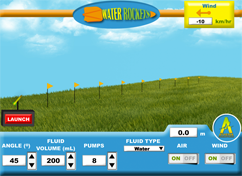Water Rockets

Water rockets work on the principle of Newton’s Third Law of Motion. Water and air are pushed out one end of the rocket, which provides a force in the opposite direction to propel the rocket forward. But what is the best amount of water to make a rocket travel the furthest? We hope that you are ready to get pumped up and find out.
What is pressure?
Pressure is defined as the force per unit area. For a given area, pressure increases with increasing force. For a given force, pressure decreases with increasing area. For example, a 5-pound book resting on a person's arm would not be too painful or cause much damage; however, if the same book was placed on the arm with a needle between the book and the arm, the increase in pressure due to the reduction in area would cause the person much pain.What is Newton's Third Law of Motion?
Newton's third law of motion states that for any applied force on an object, the object applies an equal, but opposite force. The main idea about this law is that forces always come in pairs. Any application of force on something results in the something pushing back with an equal force. For instance, a bird flies by using wings to push down on air. The air pushes back upward on the bird's wing and allows the bird to stay aloft.How do rockets fly?
Rockets use the principles of Newton's third law to fly. A rocket engine expels hot gases out of the rear of the rocket. As the particles of gas are pushed backwards out of the engine, the particles push back on the rocket in the opposite direction with the same force as they were expelled. This forward push propels the rocket in the forward direction. The hot gases are not pushing on air particles to propel the rocket forward. If this was happening, rockets could not fly in outer space where no air exists.What is drag and how does it affect flight?
Drag is the opposition to the motion of an object caused by resistance due to air. A moving car encounters drag, which acts to slow down the car. As the speed of an object increases, the amount of drag on the object also increases. The size and shape of an object can also affect the amount of drag experienced by the object as it moves through air. Since space is nearly void of air, no drag exists in space to slow vehicles down.What is a tradeoff?
Tradeoffs involve having to give up one thing in order to gain something else. The following is a good example of a tradeoff. Latiff has a collection of stunning pictures that she wants to immediately share with her friend, Peter, who lives on the other side of the country. Latiff's current computer system cannot handle her images at the high resolution. The only way to quickly send Peter her images are to compress them, which lowers their quality. Latiff must make a tradeoff between high image quality and speed of delivery.Walkthrough
Tier 2 Lessons: Grades 7 - 12+
You need to log in to access this simulation.



